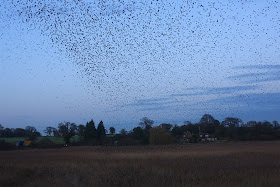We put the nets up just after dawn at Thorpeness, Peter's regular ringing site. It was interesting to find that some guy ropes left in place for the poles had been gnawed through by Muntjacs, which is not a problem we commonly get in Malaysia!
In the end we got a respectable total (for a few hours!) of 3 Robins (two had been ringed previously at the site), 2 Chiffchaffs and a female Green Woodpecker. The latter species was one that Peter hadn't ringed before, which made me feel less guilty about dragging him out on a cold morning!

Yes, it was cold!

Peter showing me something important about how to age the bird - wish I could remember what it was! I think this was an adult, which we could tell by the shape of the tail feathers, and the lack of pale tips to the tertials.

Peter getting a ring for one of the Chiffchaffs. Chiffchaff is the only Phylloscopus warbler that regularly winters in the UK.

The same bird post-release.

Measuring the woodpecker's wing.

The bird can be sexed as a female by the all black moustachial stripe - a male's would have a red centre.

The tail feathers are really stiff, as the bird uses them to prop itself against tree trunks.
After scanning the marshes and seeing mix of feral (Barnacle, Canada, Red-breasted and Greylag) and wild (White-fronted) geese and five species of duck, we went to Aldeburgh yacht club where a Great Northern Diver had just been found.

The bird was easy to find and not too difficult to approach, though the light could have been better. The pale edges to the scapulars age the bird as a juvenile.

The bird was busily, and successfully, diving for crabs.

A quick drink to wash it down...

...and then down the hatch, legs, pincers and all - that must tickle somewhat, to say the least!

Great Northerns have a characteristic bump on the forehead (or maybe it's a quiff?) formed by raised forecrown feathers.

They also tend to sit very low in the water. Apparently this has been a good year, so people are getting a bit blase about them. For me though, they're a bird of great nostalgic value - I can still remember the first one I saw, in Ipswich Docks, when I was a young teenager!

It was still happily munching on crabs when we left.

Three Eurasian Starlings. These were at Aldeburgh, but I was to see one or two more before the end of the day...

I'd been told about a Starling roost at Hen reedbeds in Southwold and that to have a chance of seeing the birds arrive I'd need to be there by 3pm. So here are the reedbeds at 3pm!

Quite a few people gradually assembled to await the birds, and one or two raptors were hanging around as well - a Western Marsh Harrier, Eurasian Sparrowhawk, and this Peregrine.

Quite suddenly and surprisingly noiselessly a large flock of birds arrived high in the sky.

The flock wheeled around and grew imperceptibly larger, as more incoming flocks merged with the main mass of birds.

I was told that there are 50,000 birds in this roost, but I didn't bother trying to make a count myself!

Eventually the flock seemed to focus over one particular area of reedbed, and appeared to shape itself into a funnel, a bit like a tornado forming!


Once they'd picked their spot, the reedbed seemed to suck them into itself.



One last mouthful, and the reedbed had swallowed 50,000 birds without a trace! The only indication that the birds were there was the cacophony of chattering calls which started up once they were safe in the reedbed. A truly awesome spectacle, and apparently every night the show is different, so worth going back!
No comments:
Post a Comment